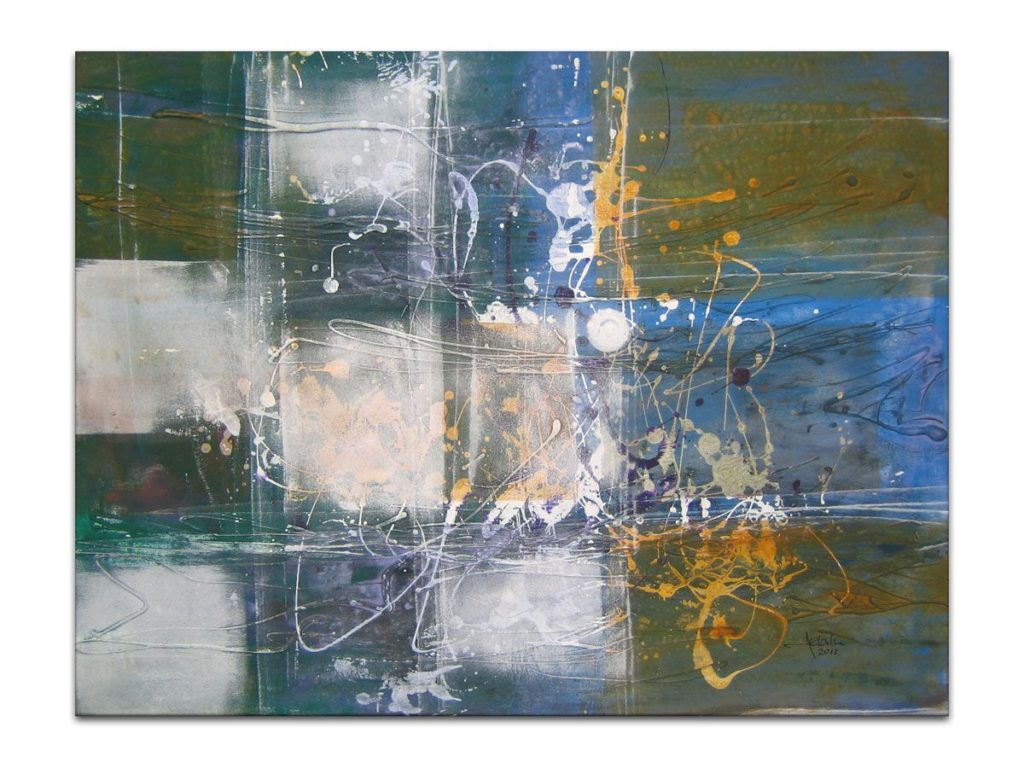Expressive abstraction has been occupying artist Chayim Shvarzblat for twenty-five years, and his latest exhibition retrospectively represents his long and successful career. The artist’s works are arranged in a circular fashion, following the shape of the Ring Gallery. Considering that they are mostly large-format works, at the very entrance, the visitor feels as if they are witnessing a great homage of abstraction in all of its glory. 
However, it is not an abstraction we’re used to, an abstraction that requires interpretation. The exhibits leave no room for dialogue between observers who will stand in front of the painting and spend hours discussing the hidden motives and messages of Chayim Shvarzblat’s works. The artist simply does not allow the primacy of the narrative, neither obvious nor covered. He does not seek enthusiasm for the subliminal message of his works, nor does he seek praise for the utilitarian intentions of his art. His art is a product of mere need. What poets call the dictates of thought without the control of reason – this is the method by which Chayim Shvarzblat’s paintings are created.
And as poets play with words, Chayim Shvarzblat plays with reduced forms. The artist creates them with simple and uniform brush strokes, densely lowering them. Arrays (which is the title of a large number of exhibits) are created properly, automatically, apparently industrial. The repetitiveness of his movements is created one specific painting manuscript after another, which is not for everyone’s taste. It proves again that the artist has no populist tendencies and that he does not seek the approval of the audience. He merely creates, as out of some obsessive need, regular strings, forming simple compositions. The result is a very unique manuscript whose apparent monotony may be repulsive to some.
The color spectrum used by Chayim Shvarzblat is limited to dark tones, usually browns and blacks, enhancing the impression of the tightness of the exhibits. He often uses the contrast of black and white. In just a few paintings, the artist uses red shades but combines them with the most represented black, so these works, while refreshing, are actually quite logical and not an overly striking part of the set. The whole exhibition is perfectly logical, full of regularity and rigor, with some hints of freedom in the form of unexpected compositions and the mentioned sudden red. It is rare for anyone to go hand in hand to get the viewer’s attention nonchalantly and, despite walking along the edges of monotony, leave the observer impressed with a specific painting manuscript.
Expressive abstraction has been occupying artist Chayim Shvarzblat for twenty-five years, and his latest exhibition retrospectively represents his long and successful career. The artist’s works are arranged in a circular fashion, following the shape of the Ring Gallery. Considering that they are mostly large-format works, at the very entrance, the visitor feels as if they are witnessing a great homage of abstraction in all of its glory. 
However, it is not an abstraction we’re used to, an abstraction that requires interpretation. The exhibits leave no room for dialogue between observers who will stand in front of the painting and spend hours discussing the hidden motives and messages of Chayim Shvarzblat’s works. The artist simply does not allow the primacy of the narrative, neither obvious nor covered. He does not seek enthusiasm for the subliminal message of his works, nor does he seek praise for the utilitarian intentions of his art. His art is a product of mere need. What poets call the dictates of thought without the control of reason – this is the method by which Chayim Shvarzblat’s paintings are created.
And as poets play with words, Chayim Shvarzblat plays with reduced forms. The artist creates them with simple and uniform brush strokes, densely lowering them. Arrays (which is the title of a large number of exhibits) are created properly, automatically, apparently industrial. The repetitiveness of his movements is created one specific painting manuscript after another, which is not for everyone’s taste. It proves again that the artist has no populist tendencies and that he does not seek the approval of the audience. He merely creates, as out of some obsessive need, regular strings, forming simple compositions. The result is a very unique manuscript whose apparent monotony may be repulsive to some.
The color spectrum used by Chayim Shvarzblat is limited to dark tones, usually browns and blacks, enhancing the impression of the tightness of the exhibits. He often uses the contrast of black and white. In just a few paintings, the artist uses red shades but combines them with the most represented black, so these works, while refreshing, are actually quite logical and not an overly striking part of the set. The whole exhibition is perfectly logical, full of regularity and rigor, with some hints of freedom in the form of unexpected compositions and the mentioned sudden red. It is rare for anyone to go hand in hand to get the viewer’s attention nonchalantly and, despite walking along the edges of monotony, leave the observer impressed with a specific painting manuscript.